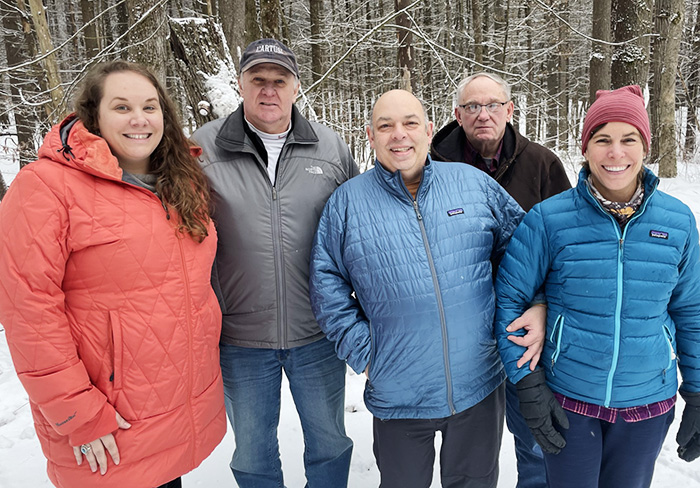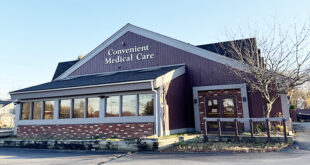By Cathy DeDe, Chronicle Managing Editor
Neighbors on Bloody Pond Road in Lake George oppose a 26-unit senior housing development proposed by Richard Schermerhorn, but the group that some have dubbed the “Bloody Pond Road gang” says it’s less about pitchforks and torches, more about communicating and seeking a solution.
The project goes back before the Lake George Town Planning Board for a second public hearing Tuesday evening, Jan. 23, at 5 p.m. in the Town Offices.

Dan Barusch, Director of Planning and Zoning for both the Town and Village of Lake George, took the unusual step of setting up a conversation between all of the interested parties last week, outside of the planning process.
The Chronicle spoke separately with Mr. Barusch; Mr. Schermerhorn’s attorney Jonathan Lapper; and members of the neighbors group — husband and wife Nabil and Kelly ElDib, father and daughter Jeff and Alex Garry, and Del Dunbar.
All agree, to paraphrase, that “something is going to happen here” and “we are trying to navigate this with civility.”
Mr. Schermerhorn originally proposed 44 units — 11 four-unit townhouses. It was then modified to one large building of 32 units. Both were deemed “too big” by the Planning Board, Mr. Barusch said.
Mr. Schermerhorn now proposes two buildings of 13 units each, a new access road/driveway, a parking lot with 43 spaces, stormwater management and landscaping.
His attorney Mr. Lapper said, “Both Warren County and Lake George have identified a need for multi-family housing. This is small, just 26 units of senior housing in the zone where multi family is allowed, in a pretty, wooded location.”
Mr. Barusch notes that three of the roughly 11 acres are deemed undevelopable — as wetlands or on too steep a slope. He said the density calculation is based on an 8-acre property, though the complex will be consolidated on more like 5 acres.

He said, “This is a tough part of zoning, because to the community and the government, it’s a good project, it’s a good use. I think it’s going to be a good way to allow some of our locals to age in place.
“But conversely, it’s a little controversial with the neighborhood, and it’s formed kind of an opposition group.
“It’s a rock and a hard place, right?
“The owner has the ability to develop the land, the neighbors have the right to continue to enjoy peace and quiet at their home to try to find a middle ground.”
‘Doesn’t belong in neighborhood’
Mr. Garry said, “We would all like to say that we do not stand against development in the Town of Lake George. We recognize the need for housing. We just figure that this particular project on this most particular piece of property is not sustainable.”
The group raises questions regarding the proximity to wetlands, access, siting of the buildings, stormwater runoff, building height, amount of fill to be taken out and and put back, locations for garbage removal and mailboxes, snow removal, increased traffic on what they describe as an already well-traveled residential road lacking sidewalks, possible impacts to water pressure with new users, even impact on wildlife.
“Our biggest thing is that this kind of building does not belong in a residential neighborhood,” Mr. ElDib said.
He said, “The biggest thing that I say to everybody is if you look out your living room window and you’re used to seeing other residences, the last thing you want to see is a hotel-like structure out your back window.”
“We are extremely appreciative that Schermerhorn and the town, everybody has been working together as a group,” Mr. Nabil said. “We want to be clear that we’re not bringing in an army to the meeting disrupt it. We want to work together.”
“We sat for an hour and a half,” Mr. Dunbar said. “We got some answers. But there are quite a few left, some of which are not going to be answered by this project, but should be thought about in terms of future development for this road.”
Mr. Garry adds, “And in the town of Lake George in general.”
Lapper: ‘Trying to make it blend in’
Mr. Lapper says of Mr. Schermerhorn, “He’s invested in the project and he’s sticking with it…He’s designed a quality project. He’s trying to make it blend in as much as he can. It’s a very involved landscape plan and I think it will look great.”
Mr. Barusch says, “From the start, the Planning Board let them know we were looking for something not like his typical projects, in terms of looks.”
The proposal includes “extensive buffering using a mix of native trees.”
Mr. Lapper said Mr. Schermerhorn even proposes to plant trees on the neighbors’ properties to add to the buffer, if needed, after the buildings are complete.
The project will tap into the town wastewater system through a dedicated sewer line extension of about 500 feet. Water service will also tap into a Village line at about the same distance, replacing the current line with something larger to accommodate the increased demand.
Mr. Lapper says at Mr. Schermerhorn’s senior housing projects, “it’s mostly people in their 70s and 80s, one car, very quiet. And it’s a small project. It won’t have a lot of traffic impact.
Planning Board’s decision to make
Neighbors say that Bloody Pond Road is especially subject to development because it has access to municipal water and sewer. “But there needs to be a plan for all this,” Mr. Dunbar said. “It’s a lot of development on one road.”
“If it isn’t going to be Mr. Schermerhorn,” Ms. Garry said, “it might be someone else. So having him listen to us and hear us does make the process a little bit easier.”
Still, Mr. Garry said, “The one big word we’d like to put forth is ‘compatibility.’”
He says, “If the Planning Board decides that this project is not compatible with the neighborhood, they are perfectly within their rights to vote against that, I believe, without retribution or any fear of lawsuits.”
Compromise notwithstanding, the group said they hope to see a smaller project of townhouses or single family homes, or even — “could the land be conserved?” they wondered.
The ElDibs, who moved here with their family about 20 years ago, and Ms. Garry, who said she grew up in the same house where she is now raising her infant, said they would consider moving away if the project goes through as proposed.
“Who’s going to buy if we leave?” Mr. ElDib asked. “People from downstate, not young families with children.”
Copyright © 2024 Lone Oak Publishing Co., Inc. All Rights Reserved
 Glens Falls Chronicle Serving the Glens Falls/Lake George region; Warren, Washington and northern Saratoga counties since 1980
Glens Falls Chronicle Serving the Glens Falls/Lake George region; Warren, Washington and northern Saratoga counties since 1980


